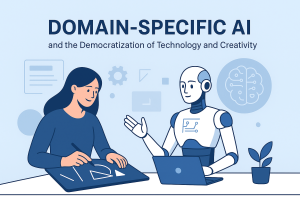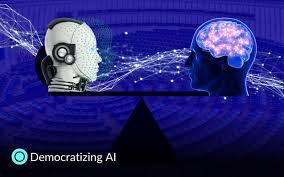Domain-Specific AI and the Democratization of Technology and Creativity
Introduction: The New Era of Intelligent Specialization

Artificial Intelligence (AI) is no longer just a futuristic concept—it’s the backbone of the modern digital revolution. However, what’s even more exciting than AI itself is the rise of **domain-specific AI**—AI systems tailored to serve particular industries, tasks, or creative domains. From healthcare to fashion, architecture to education, these specialized AIs are making advanced technology accessible to everyone, regardless of technical expertise.
Alongside this, we are witnessing the **democratization of technology and creativity**, where tools once reserved for large corporations or highly skilled programmers are now open to small businesses, creators, and everyday innovators. Thanks to low-code platforms, AI-driven design assistants, and cloud-based automation, people across the world can now bring ideas to life with minimal technical barriers.
In this blog, we’ll explore how domain-specific AI is transforming industries, empowering creativity, and creating an ecosystem where anyone can innovate.

What Is Domain-Specific AI?
Domain-specific AI refers to artificial intelligence systems trained and optimized for specific fields or applications. Unlike general-purpose AI models (like ChatGPT or Google Gemini), which are designed to understand and respond to a wide range of queries, **domain-specific AI** focuses on one specialized area—such as medicine, retail, architecture, finance, or art.
For example:
- Legal AI tools that summarize case laws and suggest legal precedents.
- Retail AIs that predict consumer trends or personalize shopping experiences.
- Healthcare AIs that detect diseases from medical images.
- Creative AIs that generate music, design layouts, or write advertising copy.
These focused systems can often outperform general AI in their chosen niche because they are **trained on curated, domain-relevant data** and built to solve targeted problems.
The Evolution: From General Intelligence to Targeted Expertise
Initially, AI development aimed for broad intelligence—machines that could perform a variety of tasks, like answering questions, playing games, or writing text. But as industries matured and data multiplied, it became clear that “specific problems required specialized intelligence”.
This shift has led to:
- Smaller, fine-tuned AI models that require less data and computing power.
- Industry-specific datasets, ensuring greater accuracy and reliability.
- Integration into business workflows, making AI more practical and results-oriented.
Companies now realize that they don’t need one AI to do everything—they need several expert AIs to handle distinct functions efficiently. This marks the beginning of a more modular and specialized AI ecosystem.
The Democratization of Technology: Empowering the Many
Traditionally, adopting advanced technology required deep technical knowledge, high budgets, and skilled teams. But today, “technology is becoming democratized”—meaning it’s accessible to anyone, regardless of background or coding experience.
Three key forces are driving this democratization:
1. “Low-Code and No-Code Platforms”
Tools like bubble, Airable, Notion, and Microsoft PowerApps allow users to build functional applications without writing code. Entrepreneurs, designers, and educators can now automate workflows, build custom dashboards, or even launch full-fledged products independently.
2. Generative AI Tools
Generative AI tools such as “ChatGPT, DALL·E, Midjourney, Runway, and Adobe Firefly enable users to create text, images, music, and videos in minutes. You no longer need to be a professional graphic designer or coder—creativity is now a dialogue between human intent and machine assistance.
3. Cloud and Edge Computing
Cloud infrastructure lets users access computing power, storage, and AI tools on-demand, while edge computing brings real-time processing closer to devices. Together, they make sophisticated AI capabilities affordable and scalable for small businesses and independent creators.
This democratization means that innovation is no longer limited to big tech firms—it’s happening in classrooms, home studios, and small startups around the world.

How Domain-Specific AI Is Fueling the Democratization of Creativity
AI doesn’t just automate tasks—it amplifies human creativity. Here’s how domain-specific AI is reshaping creative industries:
1. Design and Fashion
AI design assistants like Fotor, Canva Magic Studio, and Designify can generate visual layouts, suggest color palettes, or even design clothing patterns based on trends and user input. Designers can explore hundreds of creative directions in seconds, freeing time for concept refinement and storytelling.
In fashion, AI-driven analytics predict style trends, optimize inventory, and even customize apparel for individual customers, merging creativity with data intelligence.
2. Art and Music
Platforms like AIVA (for composing music) and Artbreeder (for digital artwork) demonstrate how AI can act as a creative collaborator rather than a replacement. Artists use AI as an idea generator—a tool for experimentation, inspiration, and expansion of creative boundaries.
AI-generated art exhibitions and hybrid human-AI performances are now part of mainstream culture, symbolizing a new creative partnership between humans and machines.
3. Writing and Content Creation
AI content platforms like Jasper, Copy.ai, and Writesonic enable bloggers, marketers, and small business owners to craft compelling copy without hiring large content teams. Specialized AI writing tools are now trained for niches such as SEO blogging, technical documentation or marketing campaigns, producing tailored results quickly and efficiently.
This empowers creators to focus more on voice, vision, and authenticity—leaving the repetitive tasks to AI.
4. Architecture and Interior Design
Architectural AI like ArkDesign and Spacemaker AI helps professionals generate structural layouts, optimize space usage, and simulate environmental impacts before construction even begins. For interior designers, AI tools can visualize spaces in different styles, colors, and lighting conditions—turning abstract concepts into tangible visuals.
This makes design collaboration faster, more interactive, and accessible even to clients with limited technical understanding.
5. Film, Animation, and Gaming
In the entertainment industry, AI is transforming workflows from scriptwriting to animation. Tools such as Runway ML and Pika Labs enable creators to produce cinematic-quality video clips or edit footage automatically. Game developers use AI to generate textures, environments, and even entire storylines.
By reducing technical barriers, AI enables indie creators to compete with established studios, diversifying the entertainment landscape.
The Human-AI Collaboration: Augmentation, Not Replacement
A major misconception about AI is that it will replace humans. In reality, the most impactful AI tools are those that augment human abilities—enhancing what we can do rather than replacing us.
Think of AI as a creative partner that:
- Handles repetitive or data-heavy tasks.
- Offers inspiration and alternative perspectives.
- Accelerates ideation and iteration cycles.
- Frees up time for strategic, emotional, and artistic thinking.
For example, a graphic designer might use AI to generate multiple concept drafts but still apply their personal taste and cultural understanding to choose and refine the final design. This synergy between human intuition and machine precision represents the future of creativity.
Challenges in the Democratization Journey
While the democratization of technology and domain-specific AI is empowering, it also introduces new challenges:
1. Quality Control and Expertise
Not all AI-generated results are accurate or high-quality. Users must still apply domain expertise to interpret and refine AI output, especially in sensitive fields like healthcare or legal documentation.
2. Ethics and Authenticity
As AI-generated content floods the internet, questions arise about originality, ownership, and plagiarism. The line between human-made and AI-made creations is increasingly blurred, making ethical guidelines essential.
3. Data Privacy and Security
Domain-specific AI systems rely heavily on data. Ensuring that user and client information remains secure is a growing priority—especially as smaller organizations adopt AI without robust cybersecurity infrastructures.
4. Digital Divide
While technology is becoming more accessible, not everyone has equal access to tools, training, or connectivity. True democratization will require bridging this digital gap across regions and demographics.
The Future of Domain-Specific AI and Creative Empowerment
As AI continues to mature, we can expect even deeper specialization and integration across industries. Here are some emerging directions:
1. Micro-AI Models
Rather than using one massive model for everything, future systems will use small, modular AIs—each trained for a specific sub-task (e.g., lighting correction in photography, voice tone adjustment in marketing).
2. AI as a Mentor
Imagine a creative AI that doesn’t just produce content but teaches you the principles behind it. These “educational AIs” will guide users step-by-step, turning creation into a learning experience.
3. Decentralized Creativity Platforms
With blockchain integration, creators will soon be able to track and monetize their AI-generated content transparently. This could protect creative rights and encourage fair collaboration between humans and machines.
4. Cross-Domain Intelligence
Future AIs will combine insights from multiple domains—for instance, using fashion design knowledge in gaming avatars or medical visualization tools in art therapy. This cross-pollination will spark new forms of interdisciplinary creativity.
Practical Ways to Leverage Domain-Specific AI Today
Whether you’re a creator, entrepreneur, or educator, here’s how you can start embracing domain-specific AI right now:
1. Identify Repetitive or Data-Heavy Tasks
Use AI to automate tasks like report generation, data analysis, or initial drafts—saving time for strategic work.
2. Experiment with AI Tools in Your Field
Try platforms specific to your industry—like **Interior AI** for designers, Synthesia for video creators, or Notion AI for writers.
3. Develop Hybrid Workflows
Combine human creativity with AI efficiency. For example, create AI-generated visuals, then refine them manually for authenticity.
4. Stay Ethically Aware
Always disclose AI assistance when appropriate and respect copyright guidelines when using or sharing AI-generated content.
5. Upskill Continuously
Learning how to collaborate effectively with AI tools is the new digital literacy. Invest time in understanding prompt design, model capabilities, and creative best practices.
Conclusion: A More Inclusive Future of Innovation
The rise of domain-specific AI marks a turning point in human progress. For the first time, technology is not just for the privileged few—it’s for everyone. Whether you’re an artist, teacher, entrepreneur, or student, the tools of innovation are now at your fingertips.
AI is not replacing creativity; it’s amplifying it. By democratizing access to powerful digital capabilities, it enables individuals and small teams to create, innovate, and compete on a global stage.
The future belongs to those who learn to collaborate with AI, not fear it. And as we move forward, the most successful creators will be those who use domain-specific AI not just to produce more—but to imagine better.
In short:
The next decade of technology won’t be defined by who builds AI—it will be defined by who *uses it creatively*. The democratization of tech ensures that anyone, anywhere, can now be an innovator.
